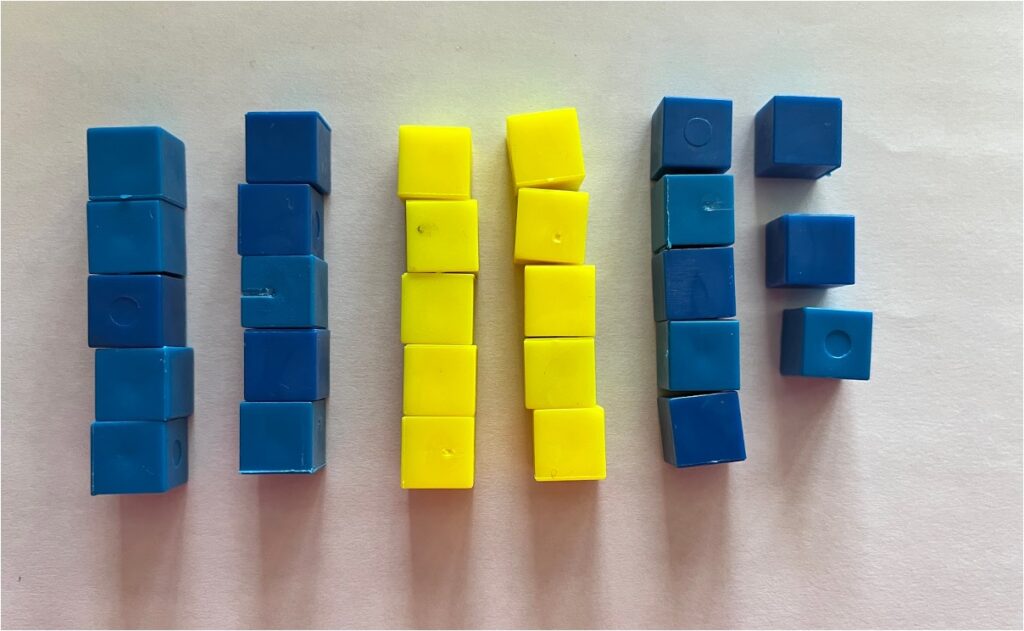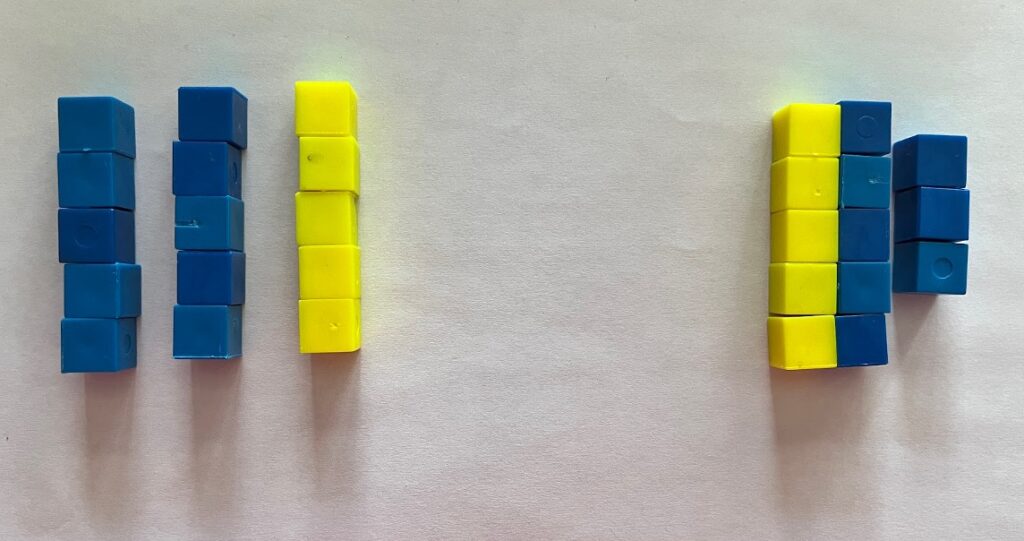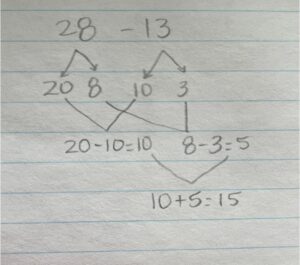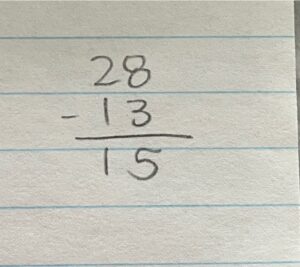PLENTIFUL POMEGRANATES
SUBTRACTION STRATEGY: PLACE VALUE TO ALGORITHM
Explore efficient strategies to subtract values within 50
Intentionality
Spark Curiosity
Fuel Sensemaking
During Moves
Student Approaches
Next Moves
Consolidation
Reflect and Consolidation Prompts
Resources & Downloads
Educator Discussion Area
Intentionality & Unit Overview

Length of Unit: 5 Days
Access each lesson from this unit using the navigation links below
Students will be presented with a subtraction context and explore the place value as a strategy to solve the problem.
Intentionality…
In this task, students will engage in a subtraction context and lead towards using place value.
Some of the big ideas that may emerge through this task include:
- Understanding hierarchical inclusion allows for flexible composing and decomposing of numbers
- Numbers can be decomposed by separating a whole into two or more parts
- Subtraction names the missing part in terms of the whole
- Different subtraction situations will elicit different strategies
- Number relationships provide the foundation for strategies to help students remember basic facts
- Subtraction can be used in either take away, comparison, or missing addend situations. This task will explore the take away method.
- Models can be used to connect concrete to abstract
Spark Curiosity
What Do You Notice? What Do You Wonder?
Show students the following video:
Then, ask students:
What do you notice?
What do you wonder?
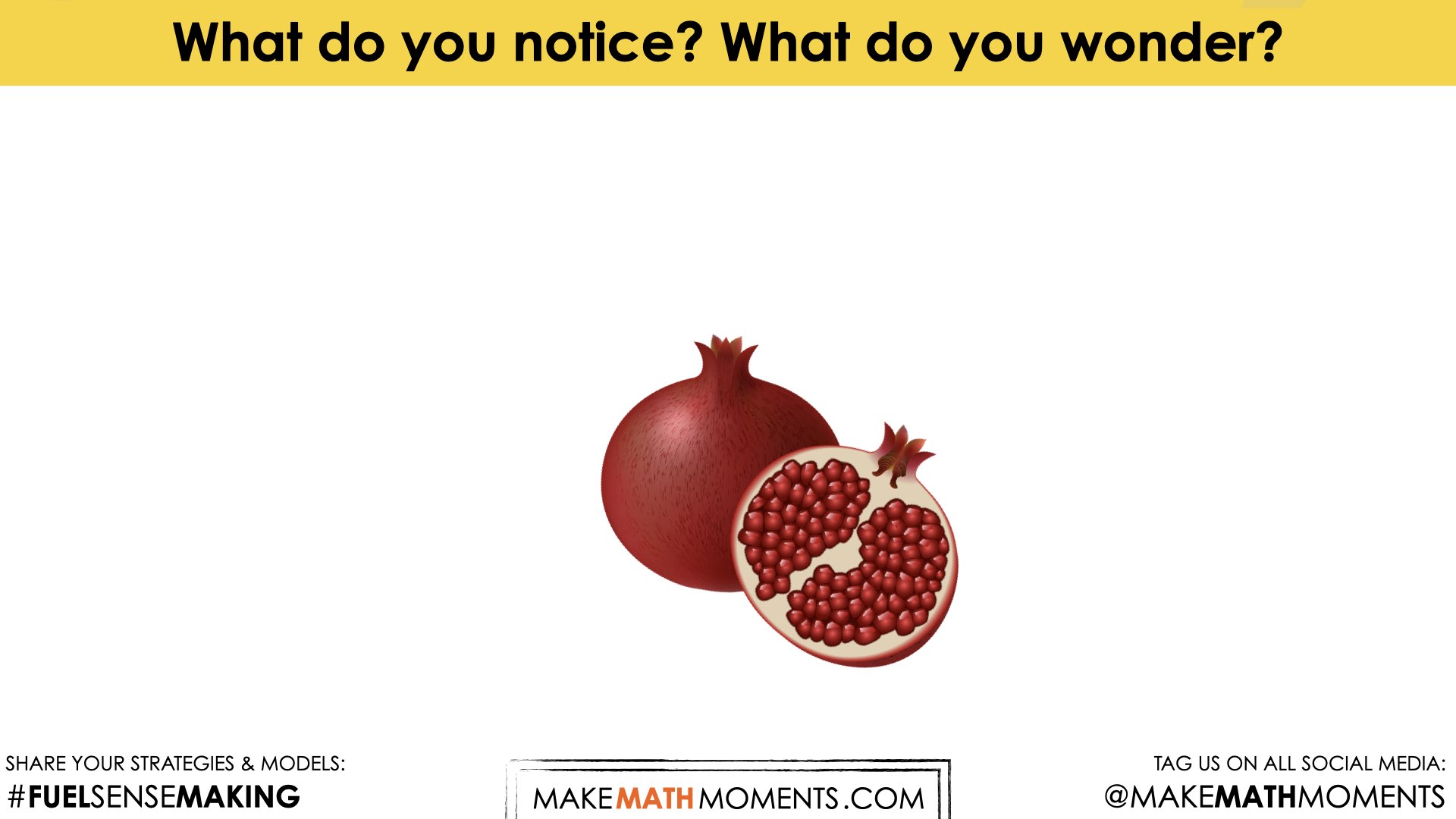
Give students about 30-60 seconds to do a rapid write on a piece of paper or silent individual think time.
Replaying the video can be helpful here if appropriate. Ensure that students do not long enough to 1:1 count each seed. This will encourage some subitizing to occur and for students to visualize what they saw.
Then, ask students to pair share with their neighbors for another 60 seconds.
Finally, allow students to individually share with the entire group. Be sure to write down these noticings and wonderings on the blackboard/whiteboard, chart paper, or some other way that is visible to all. This helps students to see the thinking of their classmates and ensures each student that their voice is acknowledged and appreciated. Adding student names or initials next to their notice/wonder is one way to acknowledge their participation and can motivate others to join in.
Some of the noticing and wondering may include:
- I notice that there are lots of red dots/seeds inside.
- I notice a red ball with a stem on top
- I wonder what this is called?
- I wonder how many seeds there are?
- I wonder how many seeds would be in the whole thing?
Estimation: Prompt
After we have heard from students and demonstrated that we value their voices, we can ask the estimation question. The students may have already made some guesses about the amount of pomegranate seeds in the previous section. The students will feel valued as you now ask them to make a true estimation.
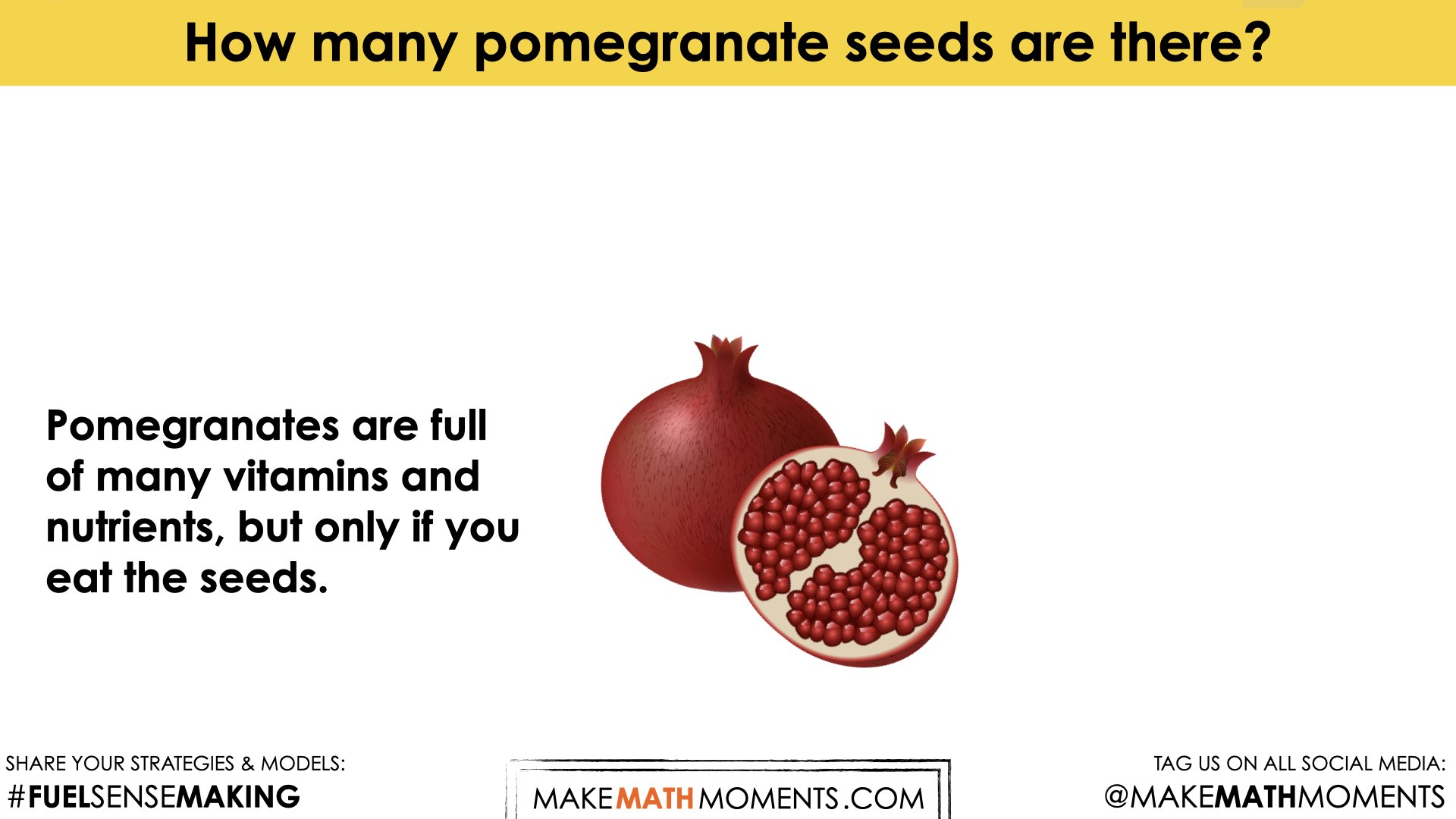
How many pomegranate seeds are there?
Follow up that question with:
How could you convince someone that your estimation is correct?
We can now ask students to make an estimate (not a guess) as we want them to be as strategic as they can possibly be. This will force them to use spatial reasoning such as the amount of seeds in a small group to help justify how many there are overall. Before collecting student estimates, students can share their estimates with neighbouring students along with the reasonings.
Consider asking students to think about a number that would be “too low” and a number that would be “too high” before asking for their best estimate in order to help them come up with a more reasonable estimate.
While Students are Estimating:
Monitor student thinking by circulating around the room and listening to the mathematical discourse. You may identify some students whose thinking would be valuable to share when the group’s estimates are collected.
Encourage students to make estimations rather than 1:1 counting each seed. The video may be paused for longer before it goes blank but we want students to make estimations based on their mathematical understanding and spatial sense.
Similar to collecting their noticings and wonderings, collect students’ range of estimates and/or best estimates along with initials or names. Having some students share justifications is an opportunity for rich, mathematical discourse.
Fuel Sense-making
Crafting A Productive Struggle: Prompt
Since you have already taken some time to set the context for this problem and student curiosity is already sparked, we have them in a perfect spot to help push their thinking further and fuel sense making.
Share the following video with the prompt.
One piece of the pomegranate has 28 seeds. To increase your vitamins, you eat 13 of them. How many seeds are still in the pomegranate piece?
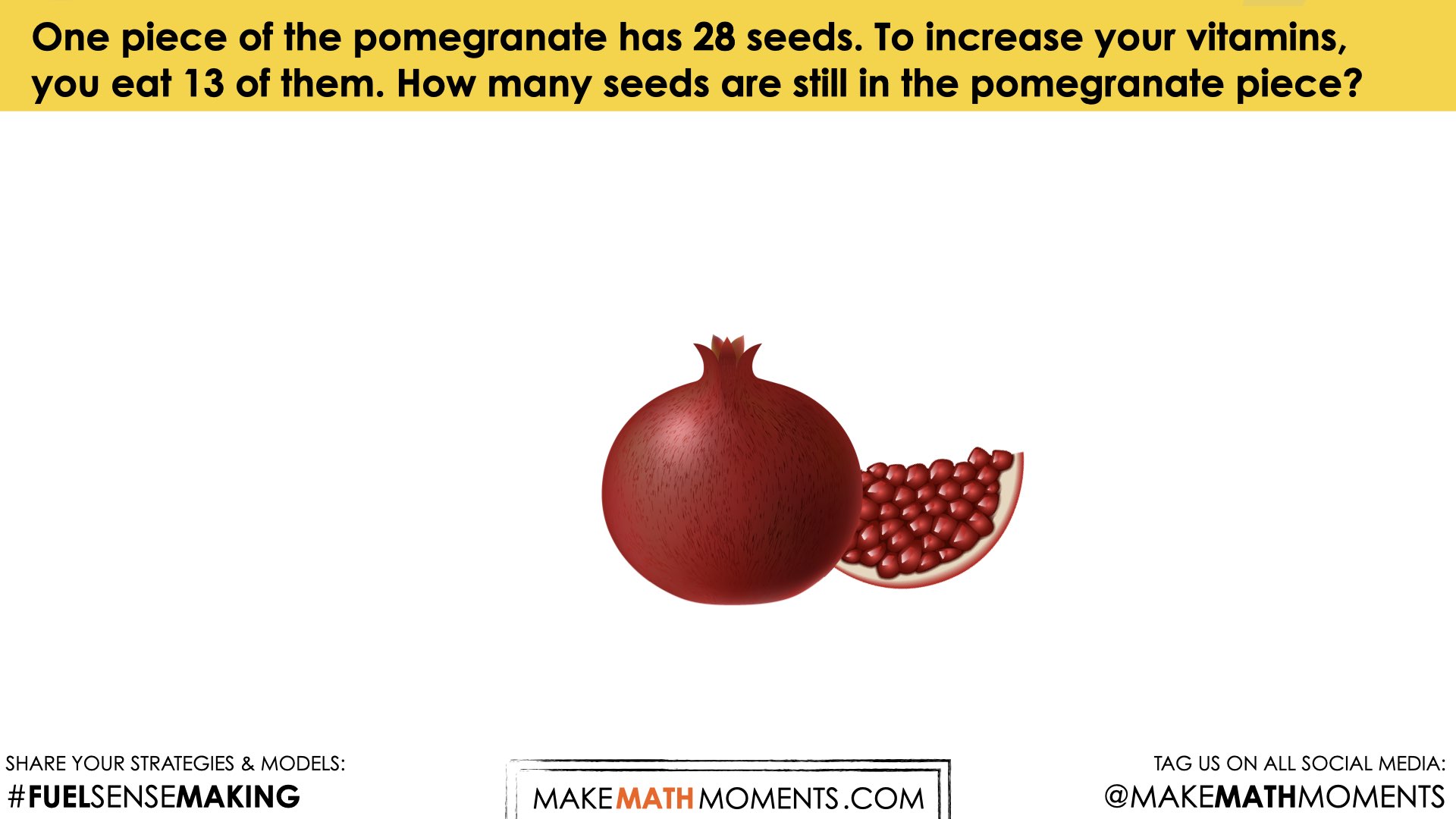
During Moves
While Students Are Productively Struggling…
Monitor student thinking by circulating around the room and listening to the mathematical discourse. Educators are looking for students that are making their thinking visible so it can be displayed during consolidation. Select and sequence some of the student solution strategies and ask a student from the selected groups to share with the class from:
- most accessible to least accessible solution strategies and representations;
- most common misconceptions;
- most common/frequent to least common/frequent representations; or,
- choose another approach to selecting and sequencing student work.
The strategies you might see students use include:
- Direct Modeling and counting all
- Counting back
- Breaking Apart the Second number
- Place Value
Assessment:
This checklist can be used for tracking formative assessment as students are working. The information collected can be used to form whole group, small group or one-to-one support models.
Early strategy | Direct modeling and counting all | Students will count the initial value, count the amount removed then count all of the amounts. Example: Count 1: 28 blocks to start Count 2: 13 of the blocks moved to the side Count 3: Count the remaining 15 blocks. |
Pre-cursor skill | Count backwards from various points | Watch for students who need to count forward before they can start counting backwards. You may hear a student that is counting back from 8, begin their count “1, 2, 3, 4, 5, 6, 7, 8” then start counting back. |
Count Back strategy | Students are holding one number in their head and continuing to count backwards and track their count | |
Count Up | Students find the difference/space between the numbers by adding up from the lower number to the higher number | |
Subtract to the decade | This skill demonstrates student understanding of place value. For example, 28 – 8, does the student understand that when subtracting the 8, we do not need to count back because we are just removing all of the singles/ones from 28. This skill needs to be done in one action, rather than counting back 27, 26, 25, 24, 23, etc. | |
Subtract from the decade | This skill requires students to transfer their understanding of the “facts of ten” to other decade numbers. For example, the fact 10 – 6 helps us with 30 – 6, or 40 – 6. | |
Strategic and efficient strategy: Breaking Apart the Subtrahend | Students may also use benchmark numbers like decade numbers (10, 20, 30, etc) when subtracting. Breaking apart the subtrahend is an efficient strategy that involves strategically subtracting parts of the subtrahend. | |
Place Value/ Algorithm | At first, students may break apart the numbers into place values. This requires a bigger mental load as students need to account for “regrouping/exchanging” from a bigger place value. E.g., 43 – 17. A student who is using place value to subtract will have to exchange a ten to be able to subtract in the ones/singles column. | |
Student Approaches
Student Approach #1: Counting All with a Tool
I counted out 28 blocks for the 28 seeds.
Then I counted 13 of the blocks and moved them to the side. I counted the rest of the blocks and there were 15. So there are 15 seeds left.
Student Approach #2: Counting All with a Drawing
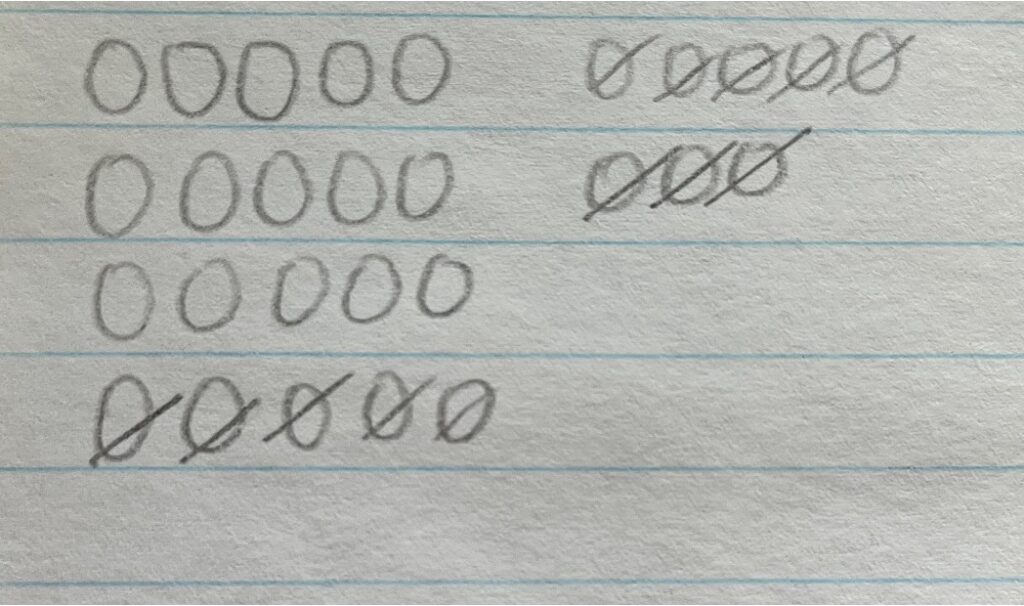
I drew 28 circles for the 28 seeds. I crossed out 13 of the circles and counted the remaining amount of circles. There were 15 circles not crossed so there are 15 seeds.
Student Approach #3: Breaking Apart the Subtrahend
I subtracted 8 from the 28 to get back to a friendlier number/decade number (20). I know that 8 + 5 is 13 so then I had to subtract 5 more to get 15.
Student Approach 4: Place Value
I split 28 into 20 and 8. Then I split 13 into 10 and 3. I subtracted 10 from 20 to get 10. Then I subtracted 3 from 8 to get 5.
10 + 5 is 15. So there are 15 seeds left.
Next Moves
Reveal #1:
Show students the following reveal video:


Reveal #2:
Show students the following reveal video:
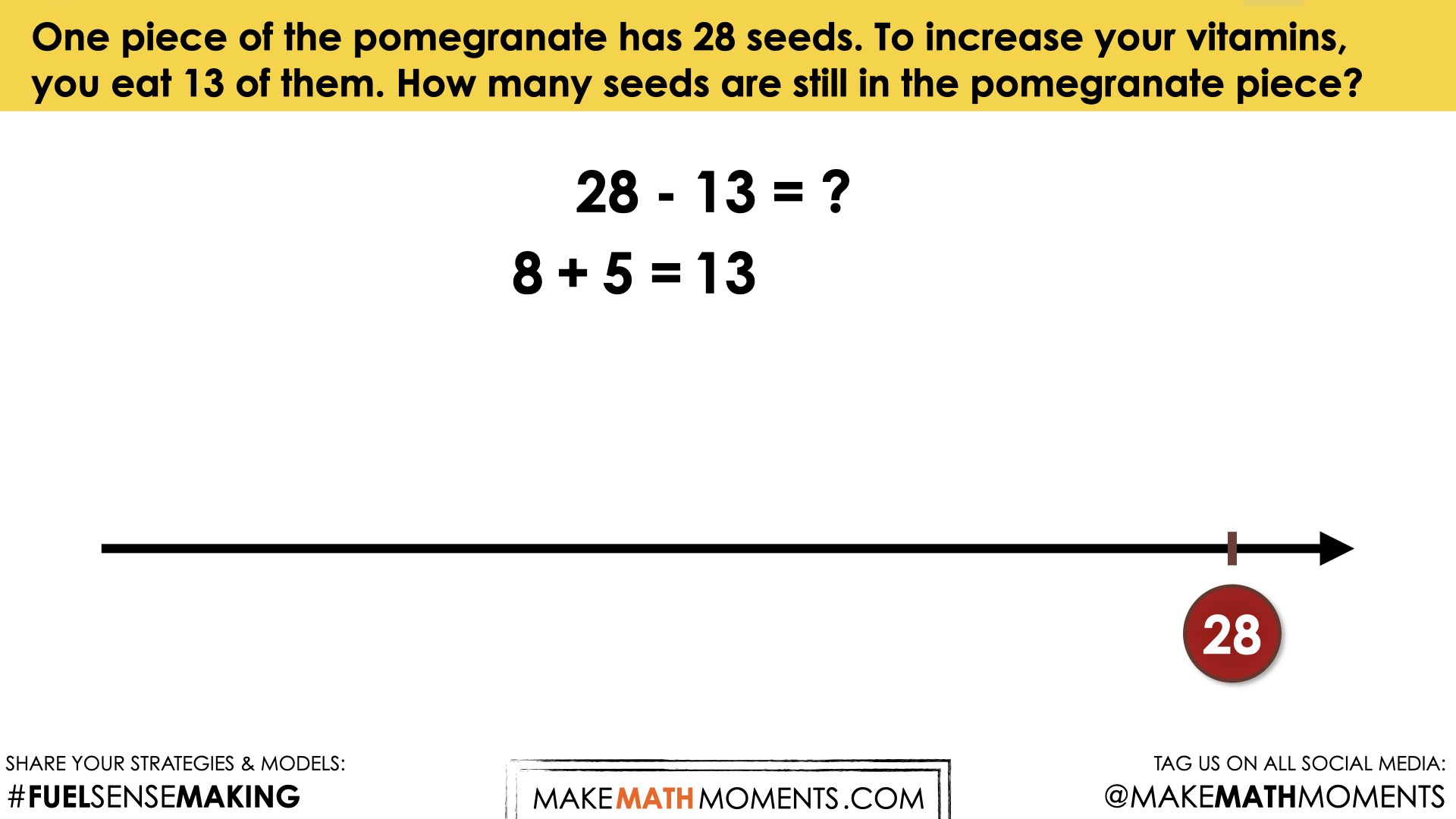
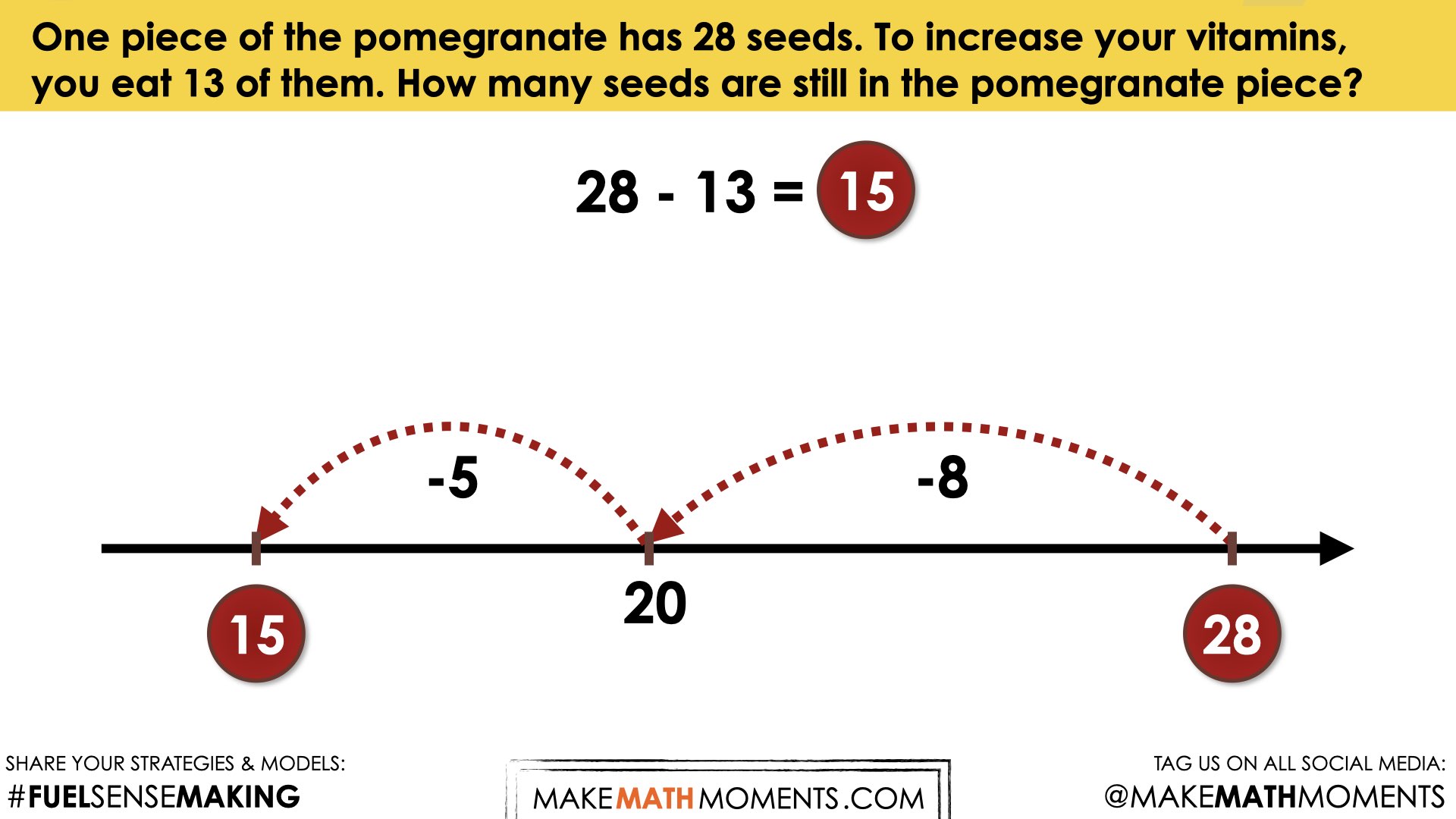
Reveal #3:
Show students the following reveal video:
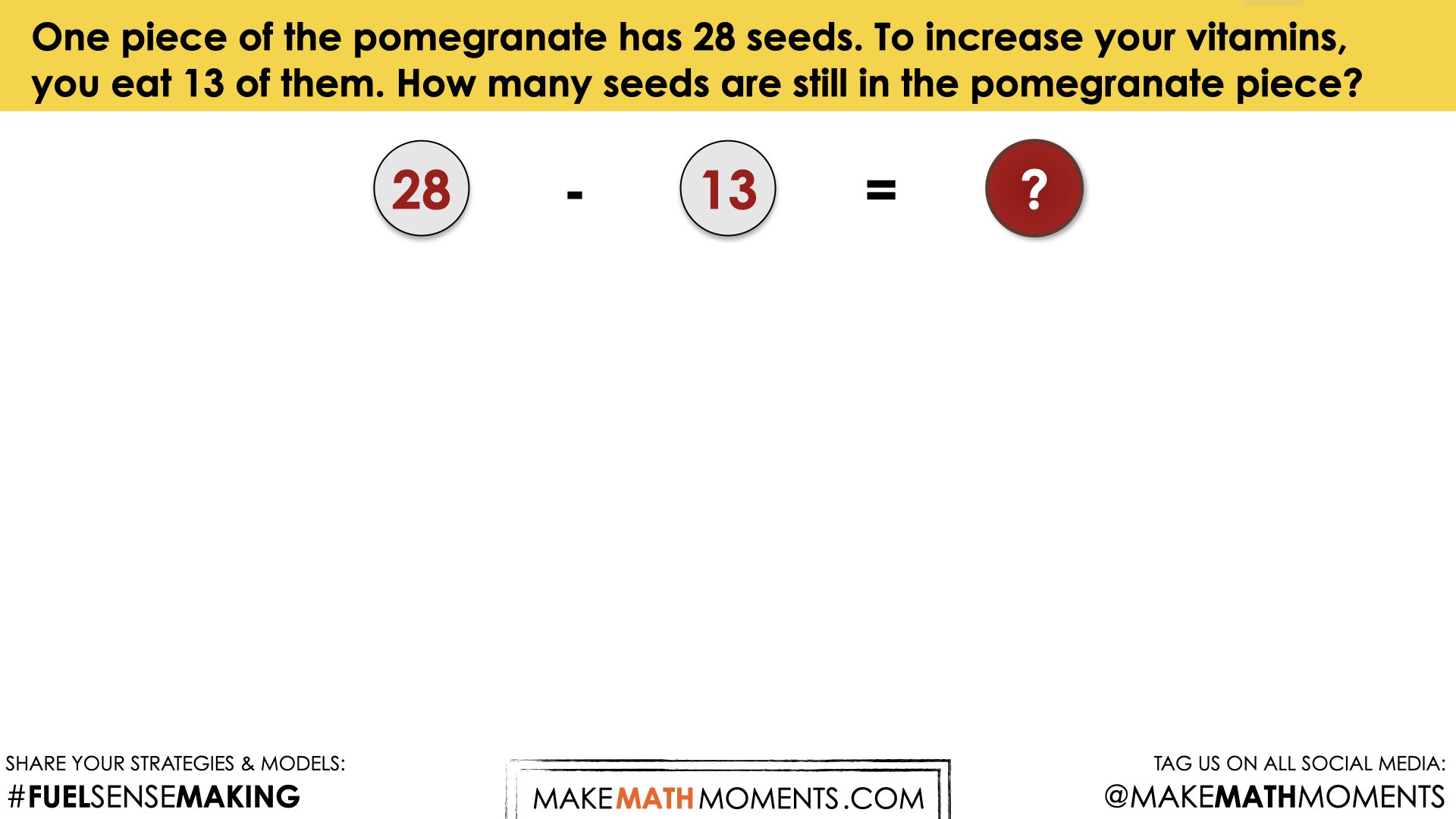
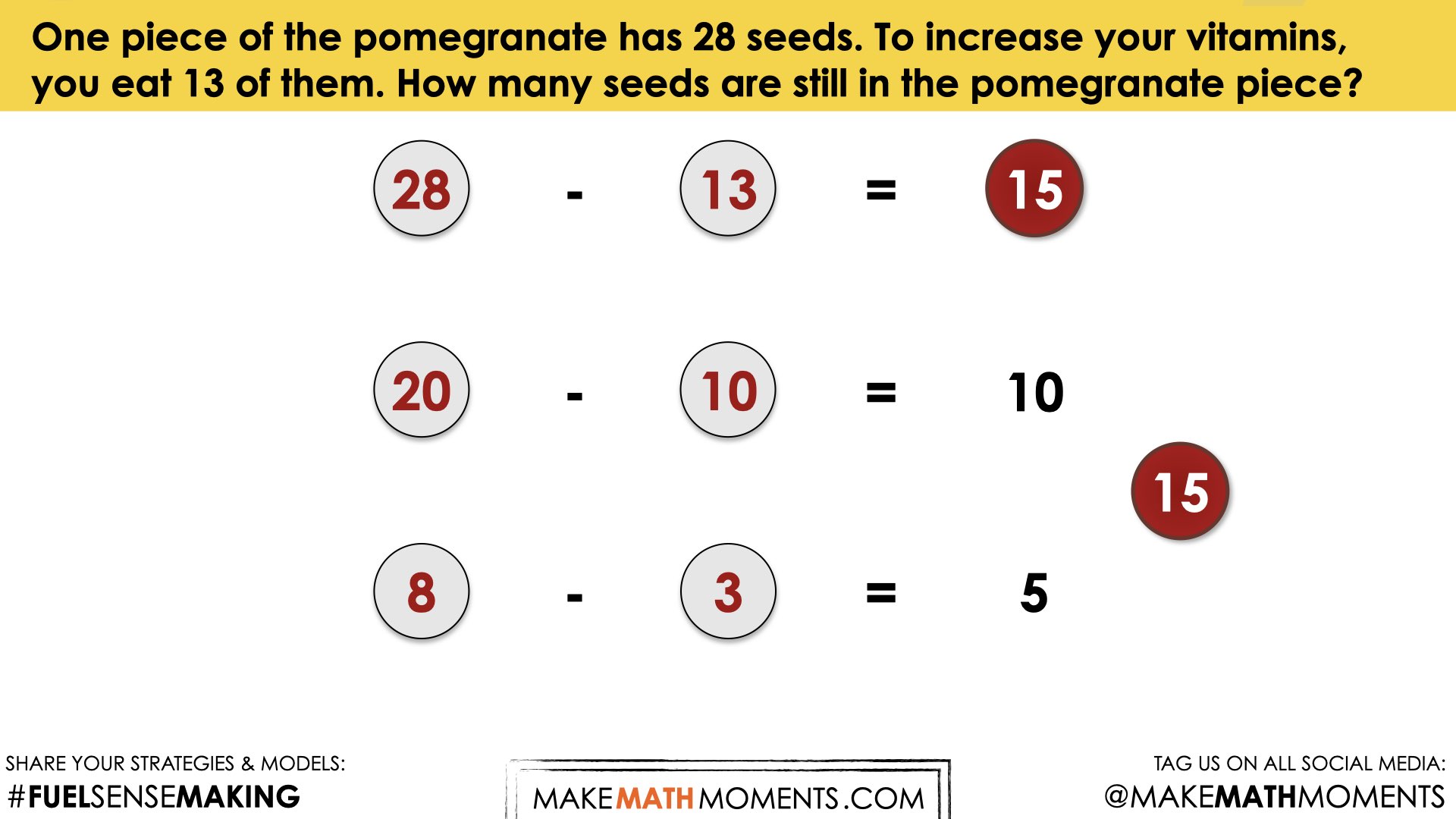
Consolidation
Consolidate learning by facilitating a student discussion.
The goal of the consolation is to demonstrate the flexible way that 13 could have been decomposed in order to make subtraction easier. Students who were counting back often “get lost” as they have to travel over a decade number. As the numbers get higher or the count back becomes larger, counting is not always as reliable. There are too many pieces for a student to keep track of.
We want students to start feeling more comfortable with subtracting numbers in a way that makes sense to them rather than just counting.
This unit addresses the interesting way that students will use place value when subtracting due to their familiarity with exploring addition strategies. When numbers do not require regrouping/exchanging then subtracting each place value separately is not a big mental load. As soon as regrouping or exchanging is needed, the algorithm often loses its meaning. In saying that, there is unlearning that needs to occur if students are mastering non-regrouping problems before learning regrouping problems. By using problem-based learning, students will develop an understanding of the process.
During the discussion, encourage students to start by showing their work without an explanation. Classmates will use this time to understand the visual and make their own assumptions about the work in front of them. It is also an option to ask students “What do you think this group did to solve this question?”. This will engage students in the work. The group can clarify any misunderstandings.
Reflect and Consolidation Prompts
After the reveal, check back to your estimations. The purpose here is to reflect on student reasoning, not on celebrating who was closest.
Were there some estimates in the right neighborhood?
What helped those students to get close?
Consider the strategies that the students used. Perhaps a review of counting back over the decade is necessary. The strategy of breaking up the subtrahend depends on students’ flexibility with decomposing numbers. It also relies on students applying the facts of ten to other decades, in this case subtracting from 20. Further review through number talks or games that work with the facts of ten and their subtraction pair may be helpful. For example, 6 + 4 helps with 10 – 6, etc.
The place value strategy likely occurred naturally through student discussion. As it is being highlighted throughout the unit, it may be helpful to discuss that portion of the reveal if students did not use that strategy. As students explain their thinking during the class discussion, listen for and highlight their explanations and representations that demonstrate place value strategies. Look for and highlight examples of students using their understanding of tens and ones to help them flexibly solve the problem in a way that is efficient and accurate.
Consolidation Prompt #1:
If you were trying to subtract 6 from 22, how should 6 be decomposed? What about 24 – 6?
Show your thinking.
Consolidation Prompt #2:
Another piece of pomegranate had 37 seeds. There were 23 seeds removed at one time. How many seeds are still in the pomegranate?
We suggest collecting this reflection as an additional opportunity to engage in the formative assessment process to inform next steps for individual students as well as how the whole class will proceed.
Resources & Downloads
Printable Lesson Plan PDF
Videos, Images & Media Files
Apple Keynote Presentation
Powerpoint Presentation
Printable Consolidation Prompts
Educator Discussion Area
Login/Join to access the entire Teacher Guide, downloadable slide decks and printable handouts for this lesson and all problem based units.
Explore Our 60+ Problem Based Units
This Make Math Moments Lesson was designed to spark curiosity for a multi-day unit of study with built in purposeful practice, number talks and extensions to elicit and emerge strategies and mathematical models.
Dig into our other units of study and view by concept continuum, grade or topic!


